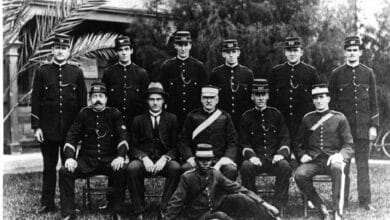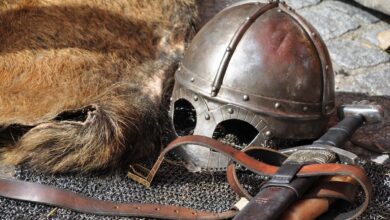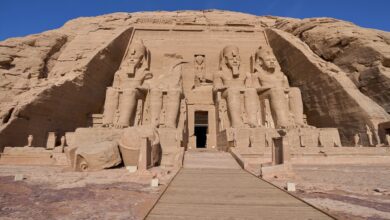The Anasazi Tribe
The Anasazi tribe were an ancient Native American tribe that lived between 700 and 1200 in the southwest region of North America. The term “Anasazi” is derived from Navajo and can mean either “ancient people who are not like us” or “enemy ancestors,” depending on how it’s pronounced. The more historically accurate and culturally respectable term today is “Pueblo People.”
Early Puebloans lived in the San Juan Basin as sedentary farmers and hunters. They initially lived in pit houses, semi-subterranean dwellings, but by around 500 AD, they began building above-ground villages. Stone masonry was widespread by 700 AD. Communities began to build large multi-room structures called pueblos.

The Anasazi Culture reached its peak between the late 1000s and to early 1100s. It spread beyond the Four Corners Region. Chaco Canyon was a major centre of culture, but it was abandoned in the mid-1100s. The reasons for this are unknown. The settlements of the Aztec Ruins and Salmon Ruins lasted only a short time, and Mesa Verde, too, was abandoned in the late 1200s. Although the fate of ancient Puebloans is still unknown, their descendants continue to live in the Hopi, Zuni and Rio Grande Pueblos.
What Does “Anasazi” Mean?
The term Anasazi, which is part of the Pecos classification system, was first introduced in 1927 to describe Native American communities such as Mesa Verde and Chaco Canyon.
The term Anasazi is derived from Navajo and can be translated to “ancient enemy” or “enemy ancestors.” Many modern Pueblos, who are descendants of the ancient people, find it disrespectful because of its negative connotation. Archaeologists, historians and others prefer to use the more accurate and culturally respectful terms Ancestral Pueblo and Ancestral Puebloan in order to honour this rich heritage of early Native American civilisations.
Culture of the Anasazi Tribe
Anasazi, or Ancestral Puebloans as they are also called, flourished in the American Southwest between 100 and 1300 AD. The Anasazi are renowned for their impressive cliff dwellings and ceremonial kivas, which are underground chambers. They also have intricate rock art.
They were skilled farmers, hunters and gatherers, who used their limited natural resources in a creative way to sustain themselves. They cultivated staples like corn, beans and squash using dryland agriculture and small-scale irrigation. They supplemented their diet by eating wild plants and game, but also traded with other cultures for valuable items like turquoise, shells and copper.

The Legacy of Anasazi Architecture
Their architectural achievements are among their most impressive legacies, such as the majestic Pueblo Bonito structures in Chaco Canyon or the dramatic Cliff dwellings on Mesa Verde. These impressive structures reveal not only a mastery of building techniques but also a profound understanding of astronomy and community planning.
Pueblo Bonito is a multi-story complex that was built around 850 AD. It has over 800 rooms and 32 kivas. The construction of Pueblo Bonito spanned over several centuries. Certain rooms were aligned with solar and celestial events, a sign of the Anasazis’ sophisticated astronomical understanding. The cliff dwellings at Mesa Verde nestled in steep canyon walls demonstrate their inventiveness in using natural rock formations as shelters, protection and water conservation.
They also left behind rock paintings that depicted animals, human figures and symbolic patterns. These pictographs and petroglyphs provide valuable insight into the Anasazi’s spiritual beliefs, everyday lives, and connection with nature.
The Basketmaker People
After A.D.500, a group of archaeologists called “Basketmakers” began migrating from the peripheral areas of Mesa Verde to its central regions. The Ancestral Puebloans were known for their intricately woven baskets that they used both in daily life and as ceremonial objects. The Ancestral Puebloans lived a mixed-subsistence lifestyle. They grew staple crops like corn, beans, and squash while also supplementing their diet with wild game and native plants.
Basketmakers have evolved both in terms of technology and social organisation. The Basketmakers developed pottery for food storage and cooking, and also adopted the bow-and-arrow to improve their hunting efficiency. This increased hunting success has led to an overexploitation of some game species, such as deer. Domesticated turkeys were a major food source in many places and eventually replaced wild game.
The Basketmakers lived in semi-subterranean, pit houses that provided insulation from both the summer heat and the winter cold. The dwellings were usually equipped with a central fire pit, storage, and a hearth. They could be entered via a roof opening using a ladder. They built large, round, partly underground structures measuring more than 100 square meters (1.076 square feet) for communal activities. These areas were used as places for community gatherings where members would conduct ceremonies, share stories and discuss important matters. Some researchers believe that these gatherings played an important role in maintaining cultural traditions and strengthening social ties.

The Rise of the Ancestral Peoples and Their Mysterious Fall
Ancestral Puebloan Culture, formerly known as Anasazi culture, reached its peak in the American Southwest between 1050 A.D. and 1125 A.D. The ancient Anasazi developed a sophisticated society that was characterised by multi-story cliff houses, advanced masonry and extensive trade networks. They also wove intricately patterned baskets. Despite the achievements of these ancient people, there are no written records to explain their eventual collapse. In Navajo, the word “Anasazi” means “Ancient Ones”, or “Ancient Enemy”.
Archaeological evidence suggests that a series of prolonged droughts, particularly the devastating “Great Drought” that began in the late 13th century, played a key role in the decline of their major urban centres, such as those in Chaco Canyon and Mesa Verde. The communities that once housed thousands of people and were comparable in size to modern cities such as Albuquerque gradually disappeared when food and water became scarce.
The Ancestral Puebloans’ legacy lives on today in the Pueblo communities, such as the Hopi, Zuni, Acoma and other groups spread throughout Arizona and New Mexico. These groups, though now scattered and living in smaller settlements, continue to preserve the cultural traditions, language, and spiritual beliefs that were passed down by their ancestors. The continued presence of these groups offers a connection to the most impressive prehistoric civilisation in North America.
Anasazi Suffers From Climate Change & Drought
Evidence indicates that droughts have contributed to the Anasazi decline. Data from tree rings reveal a severe drought between 1276 and 1299 that would have destroyed agriculture. Social unrest was likely to follow as a result of failing crops and diminishing food supplies. This led to conflict, migration and eventually the abandonment of settlements.
Conclusion
The disappearance and subsequent renaming of the Anasazi to the Ancestral Puebloans remains one of the greatest mysteries of ancient North America. Although the exact reason for their decline remains a mystery, many researchers believe a combination of environmental challenges, such as severe resource scarcity and social conflict, contributed to their gradual abandonment. This includes Chaco Canyon and Mesa Verde. The Anasazi, despite their decline, were a highly advanced society. They are known for their complex architecture, their ceremonial spaces, their agricultural innovations and their artistic expressions.
The legacy of the Ancestral Puebloans continues today through the communities and traditions of their descendants. This includes the Hopi and Zuni peoples, as well as the Rio Grande Pueblo. These living cultures honour and preserve their ancestors’ wisdom, spirituality and resilience. They preserve the Anasazi contributions through their stories, ceremonies and connection with the land. This offers valuable insights into the depth of Indigenous history and complexity in the American Southwest.




